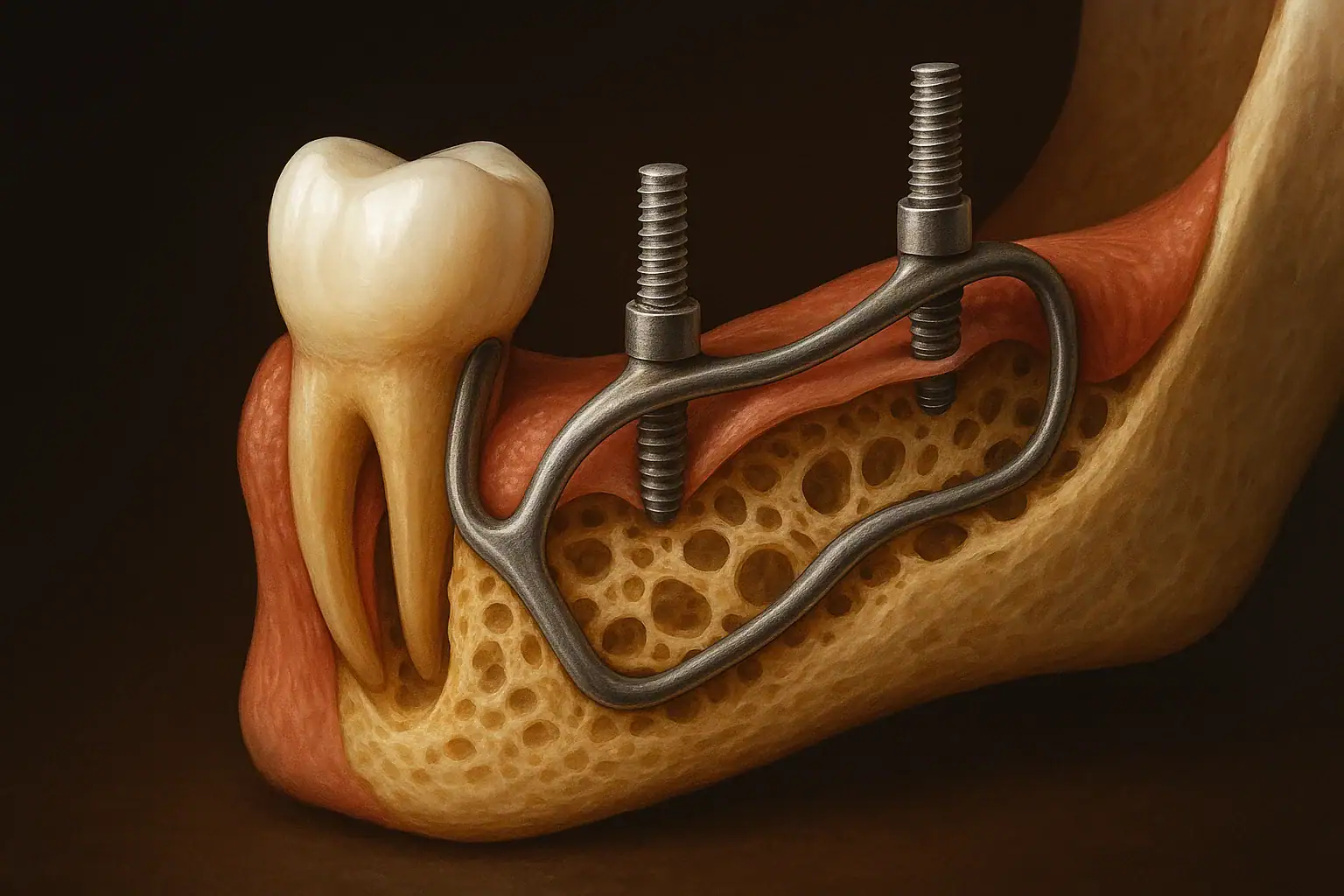Menu
Free Consultation

Did you know that around 178 million adults in the U.S. have lost at least one tooth, and approximately 40 million have lost all of them? Tooth loss can profoundly impact daily life, from eating and speaking to self-confidence and overall health. Fortunately, advancements in dental technology, including innovative solutions like subperiosteal implants, are revolutionizing smiles and restoring functionality for millions.
But what is a subperiosteal implant? Subperiosteal dental implants are a specialized type of dental implant designed for patients with insufficient jawbone density. Unlike traditional implants that are inserted directly into the bone, a subperiosteal implant is placed on top of the jawbone but beneath the gum tissue. This custom-made metal framework provides a stable base for artificial teeth, making it an ideal option for those who may not qualify for bone grafting or endosteal implants due to severe bone loss.
In this comprehensive guide, we'll explore everything you need to know about subperiosteal implants—from what subperiosteal dental implants are and who they're recommended for, to the step-by-step procedure, advantages and disadvantages, key comparisons with other implant types, and even local options for subperiosteal implants in NJ. Whether you're researching for yourself or a loved one, this article will equip you with the knowledge to make informed decisions.
If you're considering dental restoration and think subperiosteal implants might be right for you, don't hesitate to schedule a consultation with a qualified dental specialist today. Your path to a confident, functional smile could be just a step away!
If you're wondering, "What is a subperiosteal implant?" or "What are subperiosteal implants?", you're not alone—these questions often arise when exploring dental restoration options beyond traditional methods. Subperiosteal implants are a specialized type of dental implant designed as custom-made metal frameworks that rest directly on top of the jawbone but beneath the gum tissue. Unlike endosteal implants, which are screwed or inserted directly into the jawbone, subperiosteal versions provide a stable foundation without requiring deep bone integration. This makes them particularly suitable for patients with severe bone loss or insufficient jawbone density, where bone grafting might otherwise be necessary.
The framework is typically fabricated from biocompatible materials like titanium, molded to fit the unique contours of an individual's jaw using advanced imaging techniques such as CT scans. Posts protrude through the gums to support crowns, bridges, or dentures, mimicking natural tooth roots for improved function and aesthetics.
Historically, subperiosteal implants originated in the 1940s, pioneered by Dr. Gustav Dahl in Sweden around 1942-1943 as a solution for atrophic (shrunken) jaws. They gained popularity through the 1980s for treating edentulous (toothless) patients but fell out of favor due to higher complication rates compared to emerging osseointegrated implants. However, they've evolved significantly with modern technologies like CAD/CAM (computer-aided design/computer-aided manufacturing) and additive manufacturing, improving precision, fit, and success rates. Today, they're making a comeback as patient-specific, bone-anchored options for those who can't undergo traditional implant procedures.
In essence, subperiosteal dental implants serve as a vital alternative for individuals unable to receive endosteal implants, offering a less invasive path to restored oral health and confidence. If bone resorption has been a barrier for you, these could be the game-changer you've been seeking.
When considering dental restoration options, a common question arises: "A subperiosteal implant is commonly recommended for a patient with significant alveolar bone loss." Indeed, subperiosteal dental implants are an excellent choice for individuals experiencing severe bone resorption in the jaw, often due to periodontal disease, injury, congenital defects, or long-term tooth loss. These implants provide a viable alternative for those with insufficient jawbone density or height, where traditional endosteal implants would require extensive bone grafting.
Ideal candidates for subperiosteal implants include patients who wish to avoid invasive bone augmentation procedures due to health concerns, such as diabetes, osteoporosis, or other conditions that complicate healing. They're also suitable for those who cannot comfortably wear conventional dentures or have reduced jawbone volume that makes other implant types unfeasible. Regarding the query "Do subperiosteal needs implant too?"—likely meaning "Do subperiosteal implants need bone too?"—the answer is that they require only minimal bone height compared to endosteal implants, as the framework rests on the bone surface rather than embedding into it.
Other factors influencing suitability include age (typically adults with fully developed jaws), overall health, gum condition, and commitment to oral hygiene to prevent complications like infection. Always consult a board-certified periodontist or oral surgeon for a personalized assessment, including imaging to evaluate jaw structure. If you're dealing with bone loss and seeking subperiosteal dental implant options, professional evaluation is key to determining if this innovative solution fits your needs.
Understanding the subperiosteal implant procedure is crucial for anyone considering subperiosteal dental implants as a solution for tooth loss due to bone deficiency. This step-by-step process ensures a custom-fit restoration, offering a reliable alternative to traditional endosteal implants. Let's break it down into key phases.
Preparation Phase: The journey begins with an initial consultation where your dentist assesses your oral health, medical history, and jawbone condition. Advanced imaging, such as CT scans or 3D impressions, is used to create a precise model of your jawbone. This data guides the fabrication of a custom metal framework, often using CAD/CAM technology for an exact fit. This step typically takes a few weeks and ensures the implant conforms perfectly to your bone structure.
Surgical Phase: Performed under local anesthesia or sedation for comfort, the surgery involves making a small incision in the gums to expose the jawbone. The custom framework is placed directly on the bone surface, with support posts protruding through the gums to anchor future prosthetics like crowns or dentures. The gums are then sutured closed around the posts. This minimally invasive procedure usually lasts 1-2 hours and avoids the need for bone grafting.
Healing and Restoration Phase: Post-surgery, a healing period of 4-6 months allows the framework to integrate with the bone through fibrous tissue. During this time, temporary prosthetics may be used. Once healed, the final crowns, bridges, or dentures are attached to the posts for a natural look and function.
While risks are minimal, potential concerns include infection, discomfort, or nerve proximity issues, which skilled surgeons mitigate through precise planning. Always choose an experienced specialist for optimal outcomes in your subperiosteal dental implant surgery.
Subperiosteal dental implants offer numerous benefits, making them a preferred choice for patients with jawbone challenges. Here are the key advantages:
While subperiosteal dental implants offer innovative solutions for bone loss, they come with notable disadvantages and risks that patients should weigh carefully. Here are the primary concerns:
When comparing subperiosteal implants vs. endosteal implants, understanding their key differences is essential for choosing the right dental implant option. Endosteal implants, the most common type, are surgically placed directly into the jawbone, resembling small screws or cylinders for strong osseointegration. In contrast, subperiosteal dental implants rest on top of the jawbone but beneath the gums, using a custom metal framework ideal for patients with bone loss.
Success rates highlight another distinction: endosteal implants boast over 95% long-term success due to direct bone fusion, while subperiosteal implants, though a suitable alternative, may have lower rates from less integration. Use cases vary—subperiosteal implants excel for those with insufficient bone density avoiding grafts, whereas endosteal suits healthy jaws.
| Aspect | Subperiosteal Implants | Endosteal Implants |
| Placement | On the jawbone, under the gums | Into jawbone |
| Bone Requirement | Minimal | Sufficient density |
| Procedure Time | Shorter, no grafting | May require grafting |
| Success Rate | Lower long-term (effective alternative) | Higher (95%+) |
| Pros | No grafting, custom fit for bone loss | High durability, natural integration |
| Cons | Higher failure risk, cleaning challenges | Needs healthy bone, invasive |
| Costs | Higher due to the custom framework | More cost-effective |
| Suitability | Severe bone resorption | Adequate jawbone health |
If you're searching for "subperiosteal implants NJ" or subperiosteal dental implants in New Jersey, rest assured that specialized options are available across the state. Experienced periodontists and oral surgeons offer these advanced implants in areas like Holmdel, Glen Rock (near Ridgewood), Plainsboro Township, Morristown, and Linwood. Notable clinics include Holmdel Periodontics & Implant Dentistry, led by Dr. Wayne Aldredge, Ridgewood Oral Surgery, offering comprehensive care, and South Jersey Periodontics & Dental Implants, headed by Dr. Daniel Kubikian. Other providers like Alpine Periodontics in Oradell and Sage Dental NJ in Wall Township also specialize in subperiosteal dental implant procedures.
To find the best fit, start by Googling "subperiosteal implants NJ," read patient reviews on sites like Google or Yelp, and consult board-certified periodontists for personalized evaluations. Prioritize clinics with advanced 3D imaging for precise custom frameworks, ensuring optimal results for your subperiosteal dental implants in New Jersey.
Proper recovery and aftercare for subperiosteal dental implants are crucial to ensure successful integration, minimize complications, and promote long-term oral health. Unlike traditional implants, subperiosteal implant recovery focuses on healing around the custom framework placed on the jawbone, with a timeline that varies by individual but generally involves initial discomfort followed by gradual stabilization. Following expert-recommended maintenance tips can help you achieve optimal results and extend the lifespan of your subperiosteal implants.
By adhering to these subperiosteal implant recovery and aftercare guidelines, you can enjoy a functional, confident smile. Always consult your dental specialist for personalized advice tailored to your subperiosteal dental implant maintenance needs.
Understanding the cost of subperiosteal dental implants is essential for patients planning this specialized treatment for jawbone loss. Prices can vary widely based on individual needs, making it important to get personalized quotes. While subperiosteal implants offer a custom solution without bone grafting, their expenses reflect the advanced fabrication and surgical expertise required.
By factoring in these elements, you can better budget for subperiosteal implant costs. Consult a specialist for a tailored quote to ensure the best value for your dental restoration needs.
Subperiosteal implants represent a groundbreaking option for those facing severe jawbone loss, offering a custom, bone-grafting-free path to restored smiles and functionality. Ideal for patients with insufficient bone density, these subperiosteal dental implants provide stability, versatility, and long-term durability when properly maintained. While they have unique advantages over endosteal alternatives, consulting a specialist is essential to determine suitability based on your health and needs.
If you're in New Jersey, explore local experts for subperiosteal implants NJ to start your journey. Share your experiences in the comments or contact a trusted dentist today—reclaim your confident smile with informed choices!
